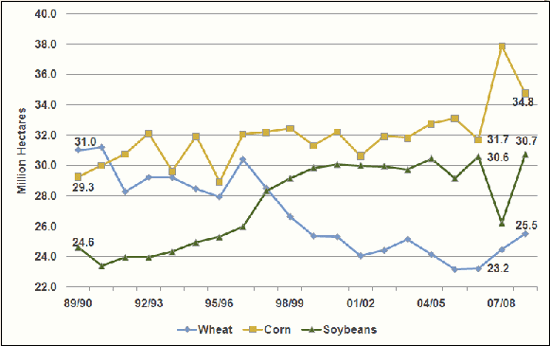Washington, DC
March 19, 2009
Source:
U.S. Wheat Associates (USW)
Wheat Letter - March 19, 2009
Of the top
three crops vying for hectares in the U.S. Midwest and Plains,
soybean plantings are most likely to rise this year at the
expense of maize (corn) and, in some areas, wheat. That is the
emerging picture seen in public and private analyst predictions
ahead of the U.S. Department of Agriculture’s (USDA) March 31
Planting
Intentions report.
Farm Futures
magazine recently surveyed nearly 1,400 U.S.
producers via email. The results showed U.S. farmers are “ready
to slash corn acres” in favor of soybeans because of low prices
and high input costs. Farm Futures Market Analyst Arlan
Suderman wrote that risk aversion is driving spring planting
decisions.
"Farmers are reluctant to commit large quantities of capital to
a crop during times of great economic uncertainty unless the
market gives them a sufficient risk premium…,” Suderman said.
Corn and soybeans are interchangeable in the traditional “Corn
Belt” where not much wheat is grown (click here to see chart in
the online version). However, corn is increasingly competitive
with hard red winter (HRW) wheat in the Plains and soybean
production is moving north into traditional hard red spring
(HRS) growing regions. U.S. wheat planted area is on a long-term
downward trend because of higher profit potential in alternative
crops and strong participation in the
U.S.
Conservation Reserve Program.
With wheat prices currently running below input costs, that risk
premium Suderman referenced does not appear favorable to wheat
for 2009/10.
A separate producer survey by a respected private analyst
predicts that compared to the 2008/09 crop, all U.S. wheat
planting will be down about 5.5 percent, or about 1.4 million
hectares (3.5 million acres). That prediction includes a two
percent decline in HRS planted area and a slight increase in
durum planted area. Results also showed that producers surveyed
intended to plant about five percent less corn and almost seven
percent more soybeans.
USDA recently forecasted U.S. winter wheat planted area at just
under 23.5 million hectares (58 million acres). That would be an
eight percent decline compared to 2008/09 including a steep drop
from last year's record soft red winter (SRW) planted area.
As reported in the
March 5
edition of Wheat Letter,a
late spring is likely in the Northern Plains where a lot of snow
still sits on soil that was already saturated before winter hit.
That is a big reason why many producers there have not yet
purchased fertilizer or seed. If conditions keep them out of the
field through April, they are more likely to plant soybeans or
pulse crops where they would otherwise plant HRS. The fact that
many producers still have HRS in storage would seem only to
support a significant drop in spring-planted wheat.
|
 |
|
The
competition for acres in the U.S. can be seen in this chart
showing planted hectares in millions for wheat, corn, and
soybeans since 1989/90. Source: USDA
|
|
|